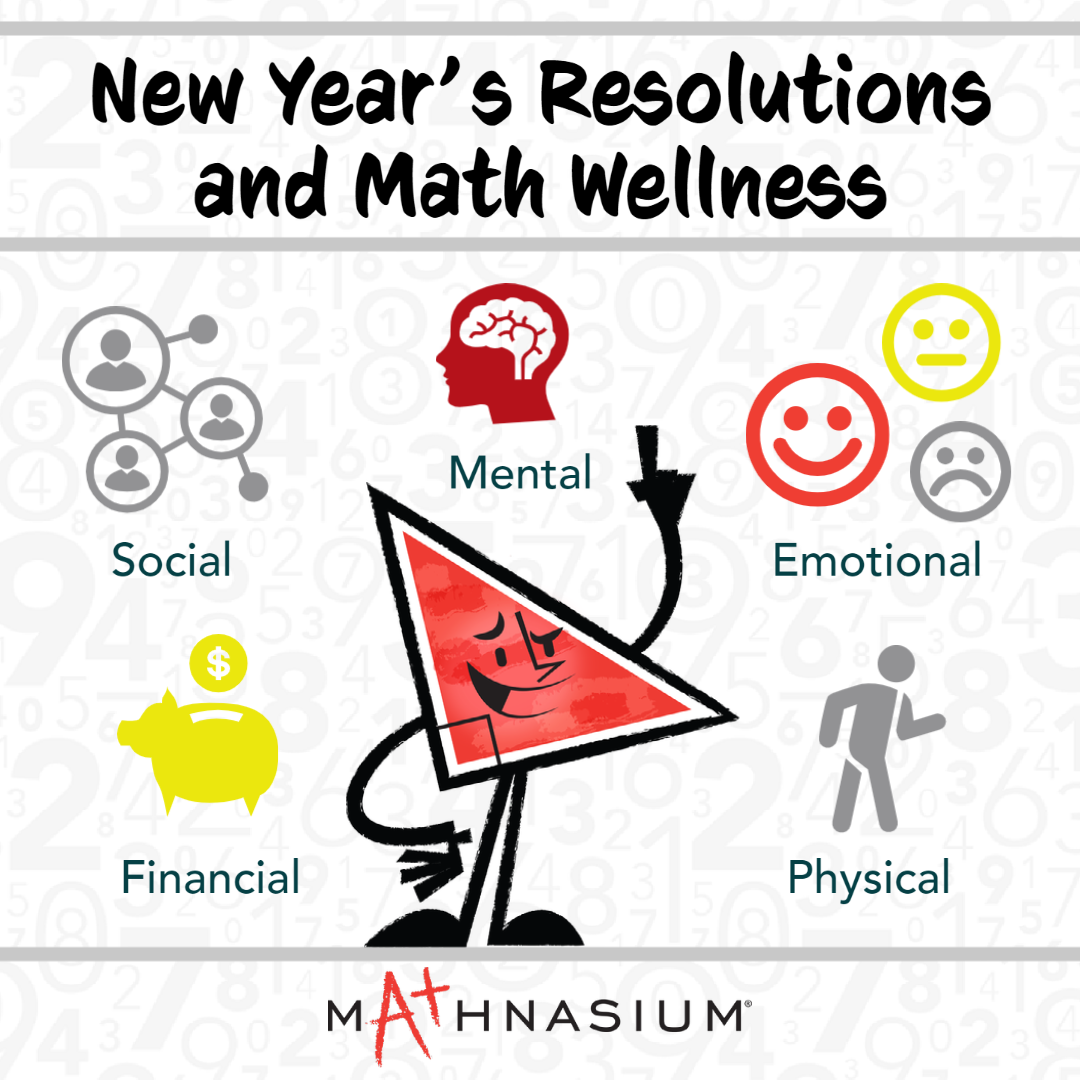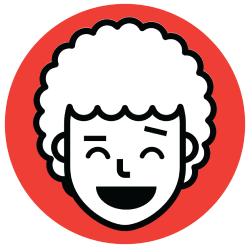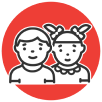A new year is right around the corner with an opportunity to start fresh. So we have a few suggestions that can help you and your child navigate the next 365 days for overall “math wellness” and success.
Making great choices for your child’s math learning does not only entail building strong study habits but also fostering an environment that inspires a love and curiosity about math. In this post, you will find suggestions for new year’s resolutions focused on building and strengthening the emotional, social, physical, mental, and financial aspects of a math learner. You may find that you have considered some of these before but perhaps did not know how to begin. Our suggestions contain examples to help you and your child get started right away!

#1: Emotional
January is the fifth month of this school year. How is your child feeling about their grade-level math so far? Now is a great time to explore their outlook with fresh eyes and make necessary adjustments.
Math presents parents with the opportunity to build emotional-learning skills for their children, including identifying and managing their emotions, recognizing sources of stress, coping with challenges, maintaining positive motivation and perseverance, and developing self-awareness.
1 Growing children require emotional guidance, and you can help your child manage their emotions when math seems too difficult, too boring, or even too easy. If anxiety has been a normal part of your child’s math discussions, consider how you can change that in 2022. Inspiring or even maintaining a love of math will mean incorporating a healthy mix of challenges.
Consider some of these strategies
1:
1. If math has often been hard and challenging, help your child identify one good thing about their math experience so far. With every challenge, there is growth.
2. Incorporate a “feelings chart” or “feelings thermometer” into your child’s math work.
3. Allow your child to sit with their emotions and to reach out for support.
4. Relieve stress through physical activities, including physical math walks (more information below).
5. Reframe negative thoughts about math by making a pros and cons list of the facts.
6. Inspire self-compassion by helping your child acknowledge when they have worked hard, tried their best, and been brave.
7. Register your child for a math competition.
Remember that strong emotional-learning skills will lead to successful academic performance in all subject areas and will build a healthy member of society.

#2: Social
This new year, incorporate more “math talk” into your child’s life.
Math understanding deepens when we share our learnings and “families are perfectly situated to talk about quantity, counting, and shapes anywhere children and families are — at home, in the park, or in the grocery store.”
2 Encourage your child to speak to someone else about the math they have learned, be it through a math lesson or informal sharing around the dinner table. Your child can take this a step further and challenge themselves to help someone who has a math question.
If your child is already attending sessions at Mathnasium, have them invite a friend to the next Math Night or game night. Math games are collaborative opportunities to practice fundamental number concepts, strategy, and logic.

#3: Physical
To complement the social math-wellness aspect, exploring math through physical exercise can provide another opportunity to share learnings. Consider taking your child on weekly math walks to discover the mathematics that exist in everything around us: in the park, the neighborhood, the mall, the library, and more! You can customize your math walks to be spontaneous trips, or planned events that include trail maps and guide points where mathematical problems are presented.
Example tasks for your next math walk can include:
1. Investigating floor patterns.
2. Exploring the shapes of street signs.
3. Studying bus schedules.
4. Estimating the height of a tree.
5. Counting the number of windows on a building.
Math is all around us, and math walks can be as stimulating as your imagination allows them to be! For inspiration, check out
https://www.urbanmathtrails.com/new-page-1.

#4: Mental
The foundation of math is number sense. This ability cannot be replaced by calculators or computers — it requires exercising “math muscles.” One of the best ways to do this is to practice mental math. Encourage your child to solve math problems in their head, without writing them down. Have them start with simple computations and work their way up to complex problems. Your child’s confidence will grow when they realize they can not only solve math problems all in their head, but they can do so a lot more efficiently and quickly than relying on traditional algorithms. Some recommended exercises are:
1. 99 + 99 +99 = ___
2. 99 x 7 = ___
3. 667 - 99 = ___
4. 12% of 25 = ___
5. Half of 31 = ___
6. 9 ÷ 11⁄2 = ___
7. What number is halfway between 3 and 21? ___
8. Count by 75s: 0, 75, ___, ___, ___, ___, ___, ___, 600, ___, ___, ___, 900.

#5: Financial
One of the best applications of math to the real world is finance. Financial literacy is an essential skill for adults. The great news is that you do not need to be an adult to get started on building this skill.
This new year, consider getting your child started with a piggy bank. The discipline of saving yields rewards later when, as adults, they have financial stability and a “rainy-day stash” for whatever life brings. This task is filled with skills such as counting money, financial planning, and goal setting. For older children, consider building a budget.
It is not uncommon to feel reluctance when discussing financial topics with your child.
1 Mathnasium’s curriculum introduces currency early on to ensure a strong foundation in financial math. We recommend that young children work with real money in today’s age filled with credit cards and digital transactions.
Feeling money and observing the physical movement between dealings can help young children recognize the impact of purchases and sales on their savings.
One simple way you can bring your child into family finances is to share receipts. Taking a moment during shopping trips to speak to the amount paid for the items bought is an effective way to introduce money and instill a useful habit.
3
Conclusion
The year 2023 holds so much potential, with the opportunity to improve your child’s “math wellness.” Whether you start implementing all of these suggestions — or perhaps just decide to tackle one resolution at a time together, remember that new year’s resolutions stem from good intentions. If you do not do well, that’s okay. Reevaluate and begin again. Just as the practice of math teaches us, it is perseverance that we want to master.
Every child’s journey will be different. You can support your child by figuring out where they currently are in their journey, and where they want to be. The end goal can be to better manage emotions, explore everyday math and share learnings, or reinforce mental math.
Mathnasium is dedicated to helping students grow a love of math. Call or stop by the Mathnasium Learning Center
nearest you anytime assistance is needed on your child’s journey. Happy New Year!
Sources:
1. Ontario Ministry of Education. (2020). The Strands in the Mathematics Curriculum. Ontario. Retrieved from: https://www.dcp.edu.gov.on.ca/en/curriculum/elementary-mathematics/context/the-strands-in-the-mathematics-curriculum
2. Caspe, M. (2018). Making Math a Family Thing. Usable Knowledge: Relevant research for today’s educators. Retrieved from: https://www.gse.harvard.edu/news/uk/18/01/making-math-family-thing
3. Huddleston, C. (2020). How To Teach Your Kids Good Money Habits. Forbes Advisor. Retrieved from: https://www.forbes.com/advisor/personal-finance/how-to-teach-your-kids-good-money-habits/

 877-601-6284
877-601-6284 877-601-6284
877-601-6284






















